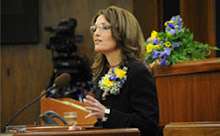Contrary to some assertions, Sarah Palin has a strong record supporting Alaskan seniors. For example, Governor Palin successfully obtained approval for a five year extension of a state program that provided monthly cash payments to low-income seniors (Palin, 2009, ¶1).
On May 23, 2007, using a rarely invoked emergency regulation, Governor Palin ordered assistance benefits to continue for Alaska’s neediest seniors after the Alaska legislature failed to fund the SeniorCare Program. After her action, the legislature responded, and on July 28, 2007, Governor Palin signed Senate Bill 4 to continue support for low-income Alaskan seniors by adopting the Senior Benefits Program. “This program continues important assistance to Alaska seniors,” Governor Palin said. “I promised that seniors would not go hungry, and we worked with the Alaska Legislature to address this critical need.” It was estimated that 10,700 Alaskan seniors would be able to benefit under the program (Palin, 2009, ¶2).
Also under Governor Palin’s tenure, on December 19, 2008, the state stepped in and took over the Mary Conrad Center, an Anchorage nursing home, when the state determined that there was “'immediate danger to the health, safety or welfare' of its residents” (Palin, 2009, ¶3)
So, with this clear record of support and care for Alaska’s seniors by Governor Palin, what is the current criticism about? According to the United States Department of Health and Human Services, prior to Governor Palin’s election in November 2006, in April of 2006, in an effort to control rapidly increasing costs for home health care providers, known as the PCA program, Governor Frank Murkowski’s administration implemented a screening process for Alaska Medicaid eligible persons by using a Level of Care assessment (LOC). The LOC assessment was designed for persons who would otherwise require hospitalization or nursing home care and was intended to help weed out fraud and abuse (Palin, 2009, ¶4).
By definition, many of these people were ill, elderly or disabled and thus in need of personal care attendants to assist them. Only registered nurse assessors were allowed to evaluate consumers to determine if they qualified for PCA care. The job of assessing consumers was contracted out, but the State of Alaska DHHS determined that the hired contractor had too much backlog. Notably, under federal Medicaid strictures, the State could not get another private business to bid on the contract. So the State was forced to take over the job in November 2007. However, the State DHHS was unable to eliminate the backlog using its own staff, and the backlog then grew. The Federal DHHS temporarily suspended new admissions to the PCA program pending audit compliance to handle the backlog of existing cases and come up with a plan to speed the assessment process. The suspension has been lifted as of August 12 (Palin, 2009, ¶5).
Further, Gov. Palin’s FY 2009 budget clearly showed her analysis of the issue as of December 2007, and described both the problem and the solution long before the federal government got involved. The backlog issue was discussed and a plan proposed for improvement (Palin, 2009, ¶6).
The graph below shows that under Gov. Palin (2007 and 2008) the backlog problem was dramatically reduced, from 30.9% in 2005 to 4.5% in 2008. Looking at these data, one can conclude that Gov. Palin substantially reduced the outstanding percentage of Medicaid assessments by 83% (Palin, 2009, ¶7).
Figure 1.
% Not Reviewed
FY 2008 4.5%
FY 2007 4.5%
FY 2006 23.18%
FY 2005 30.9%
What is the lesson in all of this? Even with good intentions, the government generally cannot provide better health care services than the private sector. Beware of complex federal laws purporting to offer government health care. For those who want nationalized medicine, take heed of this lesson (Palin, 2009, ¶8).
More information can be found here:
http://www.facebook.com/note.php?note_id=114345578434
Commentary
Let's distill what Governor Palin did to key bullet points, then we can analyze her accomplishment.
The first item has nothing to do with Medicaid, but does involve protecting needy seniors. In paragraph two, we see that the Alaska State Legislature did not fund the state's SeniorCare program -- at all -- and in in May 2007, nearly 11,000 senior citizens were in danger of losing their benefits, which involved assistance to buy food. Governor Palin excercised leadership, and signed a bill (SB-4), which established the Senior Benefits Program, which picked up where SeniorCare left off.
In the second item, the State took over a poorly run nursing home in December 2008. This item is an indirect accomplishment of Governor Palin's.
The third item forms the essence of the Medicaid backlog remediation. Governor Palin provided complete background on this. As she explained, the State contracted Level of Care (LOC) assessments to registered nurses to determine if a personal care assistant (PCA) was sufficient for a Medicaid-eligible senior, or if the person required a hospital or nursing home. But the contractor was backlogged and federal Government regulations prohibited the state from bidding the job to another contractor. The state took the job over in November 2007, but the backlog swelled, because the state had insufficient staff.
Governor Palin's FY 2009 budget delineated the problem and the solution, which was implemented. Remember -- these budgets are done two years early -- in 2008, Governor Palin did the FY 2010 budget. In 2005, the backlog was 30.5% as she explained. It dropped to 4.5% in 2007 and remained at 4.5% for 2008. This is the 83% drop in Medicaid backlog she spoke about.
The drop occurred two years BEFORE the federal government suspended new admissions to the PCA program, with that suspension being lifted today -- August 12, 2009.
From the standpoint of Reagan Conservatism, we see how this matter was handled principally at the state level. One of the core values of Reagan Conservativism is a preference for government power residing at the state and municipal levels, with a small, limited federal government. The over-arching value of a small federal government is predicated upon the position that larger government is not the answer to life's problems but more often than not causes or exacerbates them.
In this case, had the state been able to bid the LOC job out to another contractor or to multiple contractors, the backlog requiring remediation would have been considerably smaller in the first instance. We also see what happened when the state took over -- the situation got worse. Then, Governor Palin arrived at a solution to address it. But even her solution required two years to fix that mess.
This outcome clearly supports the thesis that the federal government should not meddle with health care. Big government is not the answer to the problem; it is the problem, and we can see clearly the result of a single illogical regulation -- the one that prohibited the state from bidding LOC's out to another contractor.
With this kind of a track record, why would we want a federal bureacrat making life and death decisions about our health care?
References
Palin, S.L.H. (2009, August 11). "Palin Reduced Medicaid Backlog 83% In Two Years." FaceBook, Sarah Palin. Retrieved August 11, 2009 from: http://www.facebook.com/sarahpalin?v=app_2347471856&viewas=1574531555


































No comments:
Post a Comment